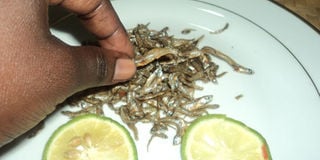Mukene, no longer poor man’s diet

Mukene can be eaten as an independent meal or mixed with groundnut sauce like above . PHOTO BY JUDE KATENDE
What you need to know:
The market for mukene is growing and demand increasing with traders exporting it to Kenya, Sudan, Rwanda and the Democratic Republic of Congo. It is a fixture on many supermarket shelves today.
From down market stalls to upmarket supermarkets and beyond Uganda’s borders, the journey of mukene reads like a success story. The silver fish, one of the three fish stocks found in Lakes Victoria and Kyoga that supports fishery in Uganda, has evolved to become a meal that breaks status boundaries.
It is savoured in the central, east and northern regions of Uganda. Known as Omena in Kenya and daaga in Tanzania, Mukene is consumed in its dried form. While you can get it from your local market vendor, the manufacturing industry has added a sophisticated touch to it by packing it thus ensuring it is clean and sometimes ready to eat. This has no doubt made it more attractive a meal and allayed its strong smell.
A perfect food supplement, is how Jean Kaahwa of Shalom Fish Limited, a company that processes mukene describes it, noting that it has the nutrients and is also a lucrative business.
According to James Wire from Realm Foods, mukene boosts immunity, so it is recommended to prevent malnutrition and is recommended for children and pregnant women. For this purpose, mukene has been modified to different variations such as powder for porridge or sauce base.
Nonetheless, mukene is often enjoyed in its full form as an independent meal or as an addition to another sauce such as beans, vegetables or groundnut stew (ebinyebwa).
Mukene is still a work in progress in as far as developing it as an export is concerned. “Adding value requires a lot of research, but with partners in Food Science and Technology department at Makerere University and the Fisheries Institute, a lot can be done. We are thinking of developing smell free Mukene, but the challenge is that it is very expensive. Something that costs Shs1500 could cost Shs30,000 just to do away with the fishy smell,” Wire says. Currently, the pricing varies as per the volume. 1 kilogramme from Shalom Fish Limited for instance costs between Shs5,000 and Shs6, 000. In supermarkets, 100 gramme packs of Nutri- Mukene costs between Shs1500 and Shs2,500.
Packs of 200 grammes, 500grammes and 1kg from Aquaculture Africa, cost Shs2,300, Shs4,400 and Shs7,500 respectively. In local markets like Ggaba market, unprocessed mukene is sold in small polythene packs at Shs500 while plastic containers and tins (debes) are priced between Shs1,500 and Shs4,000 depending on size.
COOKING MUKENE
If you buy mukene from the local market, rub off the sand, wash it thoroughly and soak it in clean cold water for 30 minutes so that sand or soil settles at the bottom.
As an independent meal
Ingredients
•Onions
•Tomatoes
•Cooking oil
•Mukene
Method
Method
•Put the mukene on a tray and sort out unwanted items like stones and dirt.
•Roast it over low heat until it browns.
•Soak the roasted mukene in water for about 30 minutes
•Fry tomatoes in oil and add spices.
•Add in the soaked mukene when the tomatoes are ready and pour a little water depending on the amount of mukene you are preparing.
•Leave it to boil for a while and add in the sliced small sized onions and salt, let it boil well for 30minutes then reduce the heat till the serving time. The onions are put last for a lasting aroma.
With ebinyebwa
•Add groundnut paste in cold water and bring to boil for 30 minutes.
•Add the soaked mukene, salt and sliced onions.
•Let it boil under low fire for an hour
-Christine Katende
==============================
Mukene contains phosphorous which aids brain and bone development. It has also got nutritional values such as vitamin A and E and fatty oils that prevent poor vision and promote good skin texture. Studies have shown that diets rich in Omega-3 can result in increased learning ability, problem-solving skills, focus, memory.




